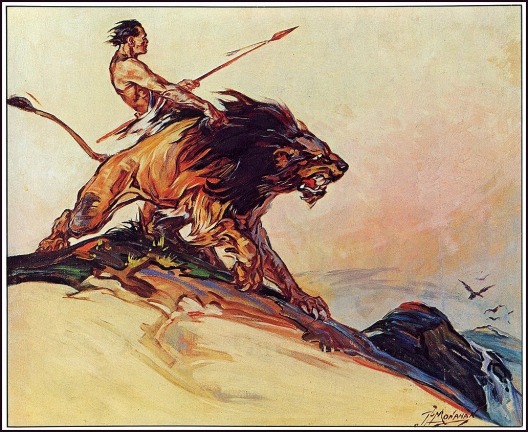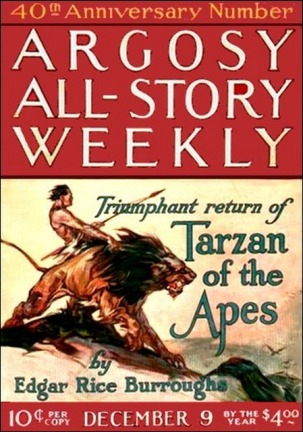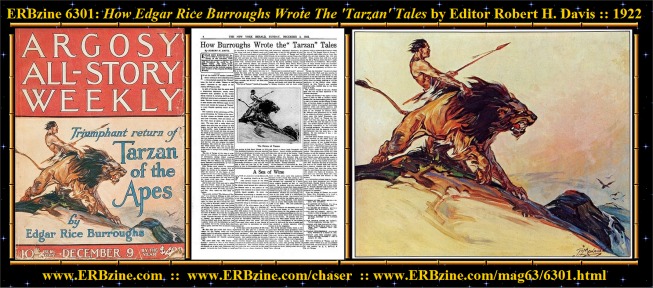How Burroughs Wrote the
"Tarzan" Tales
By Robert H. Davis
Edgar Rice Burroughs began in 1912 to write his amazing
stories of the Ape-man, since translated into numerous tongues and sold
throughout the world by the million copies. The ninth novel "Tarzan and
the Golden Lion," is the leading novel in the fortieth anniversary number
of the Argosy-All-Story Weekly.
In all the history of popular American fiction nothing
is more absorbing than a chronological record of the "Tarzan" tales, the
first of which, "Tarzan of the Apes," appeared in the pages of the Argosy-All-Story
in
1912.
In spite of the fact that the serial made a tremendous
impression, nearly every reputable book publisher in the United States
rejected it, including McClurg, who afterward secured and published it
in book form. Thirteen London publishers declined it with thanks until
Methuen came to the rescue and carried the banner of "Tarzan" to every
English speaking corner of the world.
The summary of the adventures of Tarzan is interesting.
In "Tarzan of the Apes," the first volume, an English couple, Lord and
Lady Greystoke, were put ashore on the West coast of Africa by a mutinous
crew. The man built a cabin where the couple were safe from the attacks
of wild beasts; but one day he was set upon by a huge gorilla. Lady Greystoke
came to his rescue, and though she shot the beast the shock of the encounter
unbalanced her mind. That night a son was born to her, and a year later
she died. Upon the same day her husband was killed by giant ape, one of
which, a female called Kala, having just lost her own son, adopted the
infant Greystoke. She called the man child Tarzan, which means white skin
in the language of the great apes, and reared him to maturity -- a savage
beast among savage beasts.
The life of Tarzan of the Apes is symbolic of the evolution
of man and the rise of civilization, during which mankind gained much in
its never ending search for luxury; but not without the sacrifice of many
desirable characteristics, as well as the greater part of its liberty.
How Tarzan grew almost to manhood before he saw another
human, how he fought the battles of the primitive jungle after the manner
of the beasts of the jungle, how he rose to the kingship of them all, developing
an amazing strength and a courage supreme above the very beast of the jungle
itself -- upon these things are built the action of the story.
And last came white men and a white girl, Jane Porter.
Most of the former he looked upon as weaklings and held in contempt, but
the latter he loved, and won -- and lost. Here ended the first book of
Tarzan.
The second, entitled "The Return of Tarzan," was written
in Chicago in 1912, and therein Tarzan, disgusted with civilization, returns
to his beloved jungles, where, once again, he takes his place among the
apes of the tribe of Kerchak, roams the jungle with Tantor the elephant
and wages anew his battles with Numa the lion and Sheeta the panther. He
hunts Horta the boar and Bara the deer, becomes chief of the war-like tribe
of Waziri; discovers the lost city of Opar and unseals its buried treasure
vaults. through the pages of "The Return of Tarzan" the apeman is pursued
by Nicholas Rokoff and Alexis Paulvitch, two Russians whose evil machinations
he had once foiled; but in the end he finds Jane Porter again, and this
time he doesn't lose her.
By this time the public had begun to clamor for the Tarzan
books and Burroughs turned his attention seriously to the consideration
of a market that was extending throughout the English speaking world.
The third book was "The Beasts of Tarzan," written in
1914 at San Diego. Tarzan's infant son is stolen by Paulvitch and Rockoff,
as is also Lady Greystoke the second. In search for them Tarzan is lured
to the deck of the ship upon which they are being held and is himself made
prisoner. He is marooned upon an uninhabited island off the west coast
of Africa, while his wife and baby are taken to the mainland, where they
escape with the aid of a ship's cook. Tarzan meets Akut, the bull ape,
and befriends Sheeta, the panther. With these two, a black warrior and
several of Akut's apes, he forms a savage company, which crosses to the
mainland in a war canoe. The search into the interior for Jane and the
baby is accompanied by numerous savage battles between the beasts of Tarzan
and the enemies who would thwart them. Paulvitch escapes; but h-i-s-t!
we shall meet them again.
"The Son of Tarzan," fourth of the series, was written
in Oak Park, Illinois, in 1915. The diabolical Paulvitch, who was showing
Akut as a trained ape in London, lures the son of Tarzan away. The ape
kills Paulvitch, the movie version to the contrary notwithstanding, and
young Tarzan and Akut depart for Africa. In the story Mr. Burroughs introduces
a boy and girl who lead a wild and free life in the jungle more or less
in Burroughs's best manner and introduces additional characters devised
more or less for the purpose of continuing the activities of Tarzan and
his friends for an indefinite period. These characters have a rather rough
time of it, but things shape up fairly well toward the end, and all the
beasts, including Tantor, and Bolgani, and Dango, Bara, Horta, Sheeta,
Hista the snake, and also Goob the baboon, contribute drama to the great
symposium.
"Tarzan and the Jewels of Opar," written in Oak Park,
1915, makes the fifth volume. The Apeman goes back after some more of the
forgotten ingots in the treasure vaults of the ancient city and discovers
a room full of jewels after being injured during an earthquake and losing
his memory. A Belgian murderer and an Arab raider join forces to abduct
Lady Greystoke and ruin Tarzan. Basuli is there, and Mugambi,, with other
old friends of the family. Cadj, the high priest of Opar, probably the
coarsest hidden city diplomat that ever reigned because of his jealousy
of Tarzan, spills all the beans that one man can spill in one volume. Tarzan
triumphs.
At this juncture in La's career Mr. Burroughs decided
to supply the increasing demand with a series of short stories under the
title of "The Jungle Tales of Tarzan." He released eight short stories
from Oak Park, Ill., and Los Angeles, Cal., 1916 and 1917. These stories
dealt with that period in the life of Tarzan before he knew aught of white
men or civilization. The preparation of these stories taxed his ingenuity
and caused him as much effort as three novels, but the popularity of Tarzan
survived.
"Tarzan the Untamed," the seventh book written in Oak
Park and Los Angeles in 1918 and 1919, was a contribution to the history
of the late lamented world war and explained how Tarzan won German East
Africa from the enemy drafting at will the assistance of f the British
army, which, hooked up with Tarzan's own amazing muscular gifts, enabled
him to win from start to finish.
The seventh volume is the only Tarzan book that has not
been reprinted in the German language.
"Tarzan the Terrible," the eighth volume, came to light
in 1920 at Tarzana Ranch, Reseda, Cal., Mr. Burroughs's present home. A
year or so before the late Walter Winans, Esq. of London, began to send
Burroughs clippings relative to purported encounters between white and
native hunters, and some huge creatures of prehistoric appearances in the
swamps of central Africa. Mr. Winans gave guarantees in the belief of the
existence of such a creature. Predicated upon this belief Burroughs constructed
the "Gryf" of "Tarzan the Terrible" and wove the story of the Ho-don and
the Waz-don and the land of Pal-ul-don. The author regards these as his
most fascinating experiment in the enterprise of creating monsters. He
always felt that he would have had his money's worth in entertainment had
the book been a flat failure. On the contrary, it was a tremendous success.
And now again Tarzan emerges from his jungle vastness
in the ninth story, the opening chapters of which appear in this current
number of the Argosy-All-Story Weekly under the title of "Tarzan
and the Gold Lion." The author takes the reader into another world in Central
Africa that only Tarzan could have found an conquered. The villains come
all the way from London to rob the treasure vaults of Opar and they arrive
at about the same time that Tarzan comes after another supply to fill his
war chest. The Golden Lion came to him as a cub and was curbed to the master's
will. Together the king of beasts and the king of the jungle wage war against
their enemies, conquer the holy city of the Flaming God, steal the ruling
power from La and defeat the race of gorilla men who inhabit the Valley
of Diamonds. In this story you will have Edgar Rice Burroughs at his best
and Tarzan at his bravest.
It is interesting to know that the Tarzan tales have been
translated into Swedish, Norwegian, Danish, Dutch, German, Russian and
Arabic. Offers have been made for the French, Spanish and Italian translation
rights, which the author is not yet prepared to negotiate.
Truly the history of Tarzan, as created by Edgar Rice
Burroughs, is in itself a wonder story of magic and imagination.
1--TARZAN
OF THE APES. All-Story, October 1912 (complete)
2--THE
RETURN OF TARZAN. New Story Magazine, June to December, 1912.
3--THE
BEASTS OF TARZAN. All-Story-Cavalier, May 16 to June 13, 1914.
4--THE
SON OF TARZAN. All-Story, December 4, 1915 to January 8, 1916.
5--TARZAN
AND THE JEWELS OF OPAR. All-Story, November 18 to December 16
1916.
6--THE
JUNGLE TALES OF TARZAN. Various magazines, 1916 and 1917.
7--TARZAN
AND THE VALLEY OF LUNA. All-Story, March 20 to April 17, 1920.
(Book title: TARZAN THE UNTAMED.)
8--TARZAN,
THE TERRIBLE. Argosy-All-Story, February 12 to March 26, 1921.
9--TARZAN
AND THE GOLDEN LION. Argosy-All-Story. December 9, 1922 to January
20, 1923.
With the exception of "Tarzan and the Golden Lion," which
is yet unpublished in book for, all of the above are published in this
country by A. C. McClurg & Co. of Chicago.





![]()

![]()
![]()

![]()